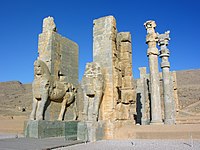Prior to 20th century
| History of Iran |
|---|
 The Gate of All Nations in Fars |
| Timeline |
- 1553 – City wall built. [1]
- 1576 – Golestan Palace completed.
- 1660 – Grand Bazaar reported to be open.
- 1723 – Afghans (Pashtuns) occupy the city. [2]
- 1751 – Takht-e Marmar built.
- 1759 – Khalvat Karim Khani built (approximate date).
- 1785 – Town besieged by forces of Agha Mohammad. [3]
- 1786 – Mohammad Khan Qajar moves Iran's capital from Sari to Tehran. [3] [4]
- 1790 – Palace built (later became Qasr Prison).
- 1796 – Population: less than 15,000. [5]
- 1810–25 – Construction of Shah Mosque. [2]
- 1829 – 11 February: Russian embassy attacked; Alexander Griboyedov and others killed. [3]
- 1834 – Ali Mirza Zill-i Sultan in power. [3]
- 1835 – Mohammad Shah Qajar in power. [3]
- 1837 – Kaghaz-e Akhbar (newspaper) begins publication.
- 1851 – Dar ul-Funun (school) founded.
- 1861 – 1 March: Unrest. [3]
- 1865 – Golestan Palace rebuilt.
- 1867 – Shams-ol-Emareh built.
- 1869
- City expanded by Naser al-Din Shah. [2]
- Population: 155,000. [6]
- 1872 – Jolfa-Tabriz-Tehran telegraph begins operating (approximate date). [7]
- 1873
- 1881 – Baharistan Palace built. [8]
- 1883 – Abyaze Palace built.
- 1888 – Teheran-Abd-al-Azim Railway begins operating. [9] [2]
- 1889 – Imperial Bank of Persia headquartered in Tehran. [9]
- 1896
- 1 May: Assassination of Naser al-Din Shah Qajar; Mozaffar ad-Din Shah Qajar in power. [3]
- Tarbiyat newspaper begins publication.
- 1899 – Tehran School of Political Sciences established.